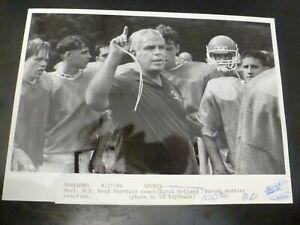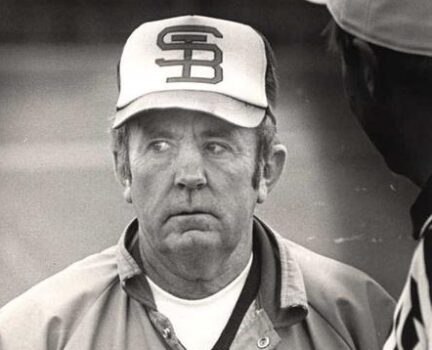Yeah, yeah. You can call it the ol’ boy network if you want, but unlike in politics, this one is not a cabal out for power. And it won’t be limited to “boys” either.
This one, loosely speaking, is about the guys who put on the shoulder pads to hit on the line of scrimmage back in the day. Or the guys and girls who put on the spikes to speed down the track. Or flashed the glove or swung the bat. Or laced the skates.
Pick the sport, there are a ton of people in my hometown of Marlborough and the other surrounding boroughs, etc., who played it BACK IN THE DAY.
Glory days, right? Hey, Al Bundy was a STAR running back for the Polk High School football team. And he TELLS people about it.
Hey, but who remembers things like: Mark Fournier suiting up as a freshman starting quarterback for the Marlboro Panthers in the 1973 season? Or Fournier breaking the home run record in the Marlboro Junior Baseball League while playing for Marlboro Transportation (orange and black were the colors) as a 12-year-old in 1971.
In those days, they would let kids go up in the booth and announce the next batter and flick the switch to put balls and strikes on the scoreboard. I know. I did that and learned quickly that it was no time to be fooling around and joking with other kids. Stan, the umpire, would look up and give a dirty look when the balls and strikes were not right. It was a time to pay attention, a skill not quite learned by the average 11-year-old. This was around that time that Hildreth School (right behind what everybody called the “Little League field”) was being expanded. The new wing of the building came pretty close to the backstop, and I’ll never forget running behind the booth from the third-base to the first-base dugout after a game and stepping on a nail that was in a board left there by the construction people. You know the drill. Call the mom, head to the hospital, get your tetanus shot.

That nail caused a certain amount of pain, but it paled in comparison to my last game with Joe Cullinan Pintos (red was the team color) as a 12-year-old in 1972. There I was at shortstop in the last inning, with tears streaming down my face. Nobody else saw it. We would have advanced had we won, but we lost after winning eight straight to nearly make the playoffs under head coach Bill Orr and assistant Don Morgan (Morgan had been the head coach in previous years). The years go by, but the memories only fade a little. It was about a year ago that my teammate at the time, outfielder Dana LeMarbre, who I became really good friends with as teenagers, told me for the first time in a while that if anyone wants to know what it was like to live those glorious times of being a 12-year-old baseball player, then talk to me. It turns out, though, that Dana has a really good story about when he was 12. I was no longer with the Pintos and they had an unbelievably great team in 1973, going something like 24-1 and winning the Marlboro Junior Baseball League title with Val Roy as the head coach. In that relatively recent conversation with Dana, he told me he hit a double off of Paul Duplessis in the championship game that broke the back of Marlboro Transportation. Duplessis, who went on to star at Marlboro High and the Marlboro Shamrocks as a quarterback and receiver in football and in hockey and baseball, was just one of the names that came up in a recent conversation with some of the guys in the previously mentioned ol’ boy network. More on that a little later.
About a month ago, I was hired as a freelancer for the Community Advocate. The plan is to write three stories per month on old-timey sports stuff. The towns covered will rotate: first up was an April 9 story on an old-school football coach: In Shrewsbury, Mario Marchisio Remembered As No-Frills 1960s Football Trailblazer.
Coming up next (really soon, as a matter of fact) will be a piece on former Olympian and Boston Bruins and New England Whalers (among other teams) hockey player Tommy Williams and his son, Bobby Williams, who starred at Hudson High and died of asthma at age 23 before what people — including general manager Harry Sinden — were saying was an imminent call-up to the Bruins.
A Marlboro story will follow, and then Westboro and Northboro and back to Shrewsbury and Hudson again. As you can imagine, I will be calling a lot of people who were involved in sports back then. It is such a RICH history. Come to think of it, I remember Ralph Grasso, my mentor at the Marlboro Enterprise/Hudson Sun back in the early 1980s, writing these types of stories on the days of yore. He knew all about stuff happening way before I was born.
One of those guys he wrote about led in a circular kind of way to me getting to cover the Boston Red Sox in the 1986 American League Championship Series and World Series. I went to and wrote about all the home games in that postseason.
—
ALSO AT BedrockSportsMarlboro.com: Liam Shanahan of Marlboro, Ivy and LSU Football Stock Could Hit the Long Ball Too
—
And so we’ll continue with that magical tangent: Red Sox rookie Steve Lyons, in 1985, hit two home runs in his first game at Fenway. Ralph knew right away: “Hey, that’s Dick “Itchy” Lyons‘ son.” Dick Lyons was a star athlete at Hudson High who Ralph occasionally wrote about. So that was my “in” to the Sox. I went to cover a few games in ’85 to write about Lyons.
Pretty soon, Rich Gedman of Worcester was on the team, so I had important “local” angles while the team rode Roger Clemens all the way to the ’86 World Series. Fortunately, this type of stuff also led to covering occasional Boston College football games with the magical Doug Flutie playing quarterback. He is still one of the most amazing athletes I’ve watched in person. The BC gig provided me with a lot of local “ins” through the years — Kevin Snow was the kicker when Flutie was playing. Mike Power of Westboro succeeded Flutie at QB. And there was a kid from Southboro, Tracy Giles, who was a running back and kick returner.
I got into the press box for some big Celtics playoff games, too, but there was no real close-to-home local angle there so I thought it best to use my time covering my real beat, which was Marlboro, Hudson, Assabet Valley and Hudson Catholic sports.
As you might imagine, I’ll probably be talking to a lot of former local big-name pre-1990 athletes in the Community Advocate coverage area. And hearing all kinds of their stories. So what follows is a small initial sample of what came out of some of my conversations so far — things that were not necessarily about the actual subject matter of the story I was assigned to write about. And to set you up properly, the following nuggets of information will be coming from: former Shrewsbury running back Maurice Bisceglia, who remembers playing against many Marlboro and Hudson premier athletes from those days; and former Marlboro High and Marlboro Shamrocks football assistant Dutch Holland, who went on to become head coach at Marlboro, Nashoba and Shrewsbury.
Part 2 of Taking Story with people in this Ol’ Boy (and Girl) Network will follow in a few days with stuff from former Hudson hockey player Chris Williams, Tommy’s son and Bobby’s brother who went on to have a collegiate and minor league hockey career of his own; gigantic sports fan and booster Bruce Caissie, who grew up in Marlboro and has a ton of Williams and New England Whalers memorabilia; and former Hudson athlete and Marlboro hockey coach Steve Jacobs, who is in his second stint as head coach at Cushing Academy.
BISCEGLIA’S 6 POINTS ISN’T ENOUGH TO TOP UNDEFEATED HUDSON
While we were talking about Marchisio’s back-in-the-day tactics of knocking players on their ass if they didn’t block the correct way and other Shrewsbury stuff, Bisceglia rolled off some of the better Marlboro players he went up against. “Lombardo, Dimitri, Phaneuf,” he said. But then he got to the best Panthers player he recalls: Russ Flagg.
“In a 13-8 loss to Marlboro, we were driving and Russ Flagg caused us not to score,” Bisceglia said. “We hadn’t beaten Marlboro in 13 years. We blew that game. Paul Drummey (the Panthers’ coach in the late 1960s and early 1970s) was also a tremendous player for them. “At a jamboree in my senior year in Hudson, we were waiting to play Hudson Catholic and some Marlboro guys came over to give us shit about how they’ll beat us the following week. Mario said to us, ‘Go sucker that kid and shut his mouth.’ ”
For good or ill, those were the days where that stuff was on the normal side. One of Bisceglia’s biggest high school moments was a 90-yard kickoff return for a touchdown against Hudson, a team that went undefeated that year, in a 7-6 loss. “Mario scouted them five times and we almost beat them,” added Bisceglia, who was quick to point out that the Colonials only gave up those 7 points in a four-game span that started after Marchisio got pissed off after a 40-0 sloppy loss to Maynard.
HOLLAND REMEMBERS HUCK HANNIGAN’S ARRIVAL AT MHS
Offensive line coach Holland was there for Marlboro’s huge turnaround under Huck Hannigan, who had been a highly successful coach at Leominster and was lured over to Panther-ville.
He was one of Hannigan’s original assistants in the 1976 season, along with guys like Vinny Joseph, Jim Ford and Jeff Long. Ford went on to become the Panthers’ head hockey coach, and Long eventually served many years as athletic director. Holland also played for Marchisio at Shrewsbury and started to rattle off some names of great Colonials running backs. When he got to the name of Bobby Catalina, it started to ring some bells. Somehow, I had heard of that name.

“Bobby Catalina was a tremendous fullback and went out to play for New Mexico Highlands,” Holland said. “He went out there with Kenny Reynolds. They both played for Ted Rolfe in Northboro Legion (baseball).” Reynolds, of course, went on to the majors with the Philadelphia Phillies, St. Louis Cardinals, Milwaukee Brewers and San Diego Padres. After that, he coached the Marlboro High baseball team for many years in the 1980s. And, so you can bet that Reynolds is on the list of look-back story ideas for the Community Advocate.
Holland’s first coaching job came under Marchisio at Shrewsbury with the 1970 JV team. He wound up becoming the head man at Nashoba, Shrewsbury and Marlboro (1990-96). And Holland was also an assistant with the 1983 Panthers, when Joseph was the head coach.
As I recall, that was an EXCELLENT football team, and so I gave Dutch some of my thoughts about them. He remembered it well. “Aside from two close losses to Milford and Westboro, it’s an undefeated team,” I told him.
—
ALSO AT BedrockSportsMarlboro.com: Ges’ ‘My Old Friend’ Is The Album Of The Year That You Can Only Hear Here
—
The Panthers finished 8-2 in ’83, beating Hudson 24-6 on Turkey Day, with wide receiver Dave Lambert winning the MVP trophy. I told Holland that I remembered good ol’ Doc Cannon, the pipe-smoking doctor who was on the sidelines of many Marlboro sporting events through the years, coming over to check on DB/LB Gary Kraft, who had gotten his bell rung at Milford and didn’t know where he was for a second.
And since we’re at it, I had Joseph for film study class as a senior and I remember him smiling and giving me a little ribbing about the green suit and tie I wore on St. Patrick’s Day in 1978, just three months before my graduation.
Another possible story down the line in this space or in the Community Advocate could be one on Steve Gaucher, who went from a pulling guard for the Marlboro Panthers one season to the Massachusetts scoring leader at halfback with 150 points in 1958. That idea came from Holland, who also brought up the names of Paul “Mousey” Lombardo, the starting quarterback for the Panthers in an undefeated 1963 season, and Jackie Wallace as being some of the Marlboro studs. The story ideas abound!!!! And this dude abides (see “The Big Lebowski” or watch clip below).
That list of Massachusetts scoring leaders, by the way, brings up some familiar names — like Bob Yesue of Hudson Catholic (140 points in 1966), Dick Jauron of Swampscott (161 points in 1968) and Mike Esposito of Wilmington (191 points in 1970). Yesue is the owner of Roc’s, “the” place to get your haircut on Marlboro Main St. when it opened in the mid-1970s. That was right around the time when people were getting their haircuts again as the nation’s counterculture days of long hair, peace signs and bellbottoms faded away and got swept into the gutter by the street cleaner (once again, for good or ill). Yesue’s place of business is still there on Main St., and it’s now called Roc’s Unisex Salon.

Jauron needs little introduction. He was a star running back at Yale and has since been a head coach with the Chicago Bears (1999-2003), Detroit Lions (interim, 2005) and Buffalo Bills (2006-09) and an assistant at various times through 2012 with Buffalo, the Green Bay Packers, Jacksonville Jaguars, Detroit, the Philadelphia Eagles and Cleveland Browns.
Esposito was a standout running back at Boston College and played a few seasons for the Atlanta Falcons. According to Wikipedia, a photograph of Esposito and a young Shriners Hospital patient — while he was on a visit as a representative of the 1974 East-West Shriners Game — became the inspiration for that all-star game’s logo. See below.

And Holland has some great memories of Hannigan’s first year with the Panthers, 1976, after many lean seasons in the late 1960s and early 1970s. LaFreniere was a senior on that team.
 Huck Hannigan, when he was coaching
Huck Hannigan, when he was coachingat St. Bernard’s in Fitchburg, after his stint at Marlboro.
ALSO AT BedrockSportsMarlboro.com: Time Traveling With Assabet Valley Aztecs And Marlboro Shamrocks Kicker Pat Caruso
—

